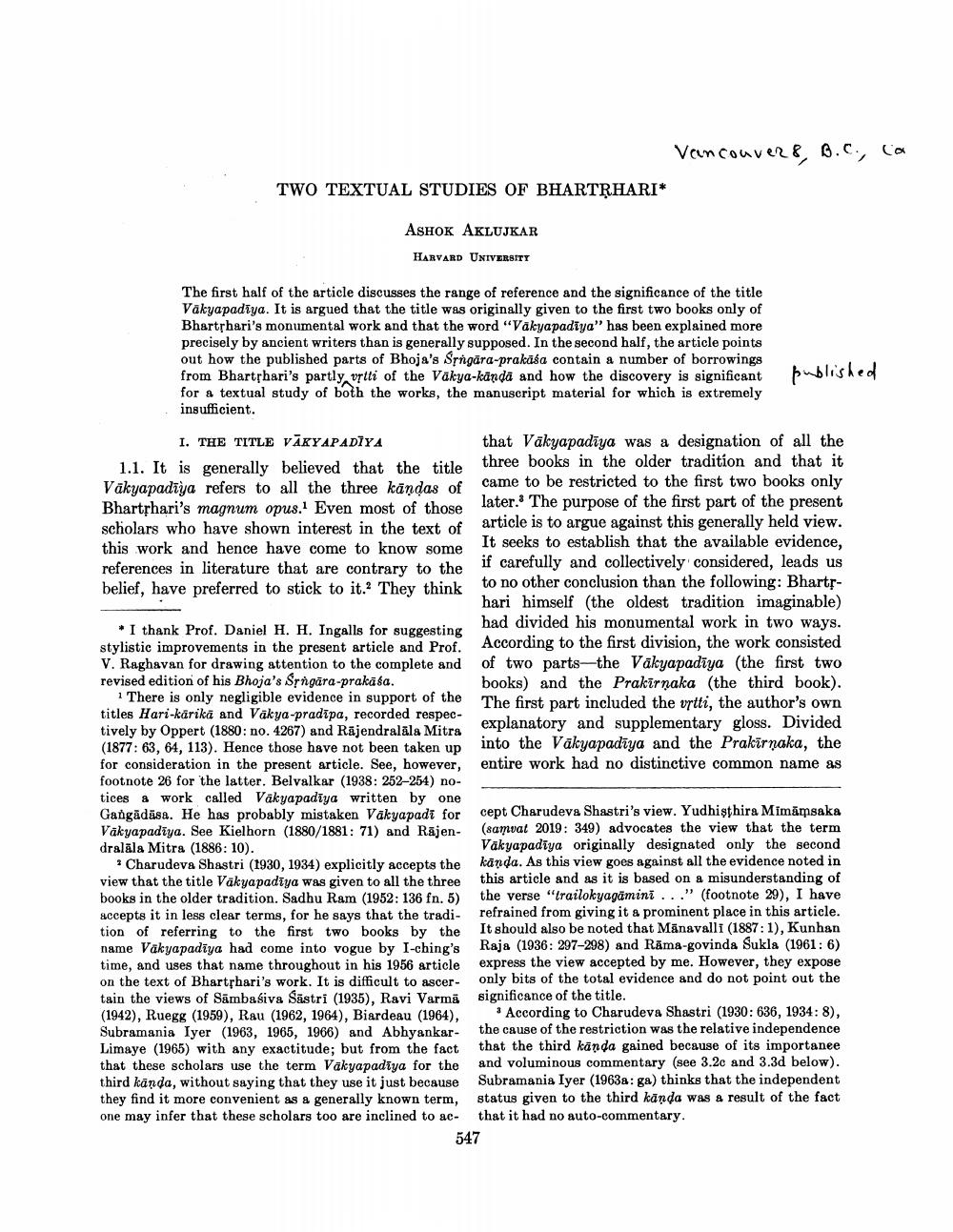Book Title: Two Textual Studies Of Bhartrhari Author(s): Ashok Aklujkar Publisher: Ashok Aklujkar View full book textPage 1
________________ TWO TEXTUAL STUDIES OF BHARTRHARI* ASHOK AKLUJKAR HARVARD UNIVERSITY The first half of the article discusses the range of reference and the significance of the title Vākyapadiya. It is argued that the title was originally given to the first two books only of Bhartṛhari's monumental work and that the word "Vakyapadiya" has been explained more precisely by ancient writers than is generally supposed. In the second half, the article points out how the published parts of Bhoja's Sṛngara-prakasa contain a number of borrowings from Bhartṛhari's partly vṛtti of the Vakya-kanda and how the discovery is significant for a textual study of both the works, the manuscript material for which is extremely insufficient. 1. THE TITLE VAKYAPADIYA 1.1. It is generally believed that the title Vakyapadiya refers to all the three kändas of Bhartṛhari's magnum opus.1 Even most of those scholars who have shown interest in the text of this work and hence have come to know some references in literature that are contrary to the belief, have preferred to stick to it. They think I thank Prof. Daniel H. H. Ingalls for suggesting stylistic improvements in the present article and Prof. V. Raghavan for drawing attention to the complete and revised edition of his Bhoja's Sṛngara-prakāśa. 1 There is only negligible evidence in support of the titles Hari-kärikä and Vakya-pradipa, recorded respectively by Oppert (1880: no. 4267) and Rajendralala Mitra (1877: 63, 64, 113). Hence those have not been taken up for consideration in the present article. See, however, footnote 26 for the latter. Belvalkar (1938: 252-254) notices a work called Vakyapadiya written by one Gangadāsa. He has probably mistaken Vakyapadi for Vakyapadiya. See Kielhorn (1880/1881: 71) and Rajen dralala Mitra (1886: 10). Vancouver, B.C., Ca published that Vakyapadiya was a designation of all the three books in the older tradition and that it came to be restricted to the first two books only later. The purpose of the first part of the present article is to argue against this generally held view. It seeks to establish that the available evidence, if carefully and collectively considered, leads us to no other conclusion than the following: Bhartrhari himself (the oldest tradition imaginable) had divided his monumental work in two ways. According to the first division, the work consisted of two parts-the Vakyapadiya (the first two books) and the Prakirnaka (the third book). The first part included the vrtti, the author's own explanatory and supplementary gloss. Divided into the Vakyapadiya and the Prakirṇaka, the entire work had no distinctive common name as cept Charudeva Shastri's view. Yudhisthira Mimāmsaka (samvat 2019: 349) advocates the view that the term Vakyapadiya originally designated only the second kanda. As this view goes against all the evidence noted in this article and as it is based on a misunderstanding of the verse "trailokyagamini..." (footnote 29), I have refrained from giving it a prominent place in this article. It should also be noted that Mänavalli (1887: 1), Kunhan Raja (1936: 297-298) and Rama-govinda Sukla (1961: 6) express the view accepted by me. However, they expose only bits of the total evidence and do not point out the significance of the title. Charudeva Shastri (1930, 1934) explicitly accepts the view that the title Vakyapadiya was given to all the three books in the older tradition. Sadhu Ram (1952: 136 fn. 5) accepts it in less clear terms, for he says that the tradition of referring to the first two books by the name Vakyapadiya had come into vogue by I-ching's time, and uses that name throughout in his 1956 article on the text of Bhartṛhari's work. It is difficult to ascertain the views of Sambasiva Sastri (1935), Ravi Varma (1942), Ruegg (1959), Rau (1962, 1964), Biardeau (1964), Subramania Iyer (1963, 1965, 1966) and AbhyankarLimaye (1965) with any exactitude; but from the fact that these scholars use the term Vakyapadiya for the third kanda, without saying that they use it just because they find it more convenient as a generally known term, one may infer that these scholars too are inclined to ac 547 3 According to Charudeva Shastri (1930: 636, 1934: 8), the cause of the restriction was the relative independence that the third kanda gained because of its importanee and voluminous commentary (see 3.2c and 3.3d below). Subramania Iyer (1963a: ga) thinks that the independent status given to the third kanda was a result of the fact that it had no auto-commentary.Page Navigation
1 2 3 4 5 6 7 8 9 10 11 12 ... 17
